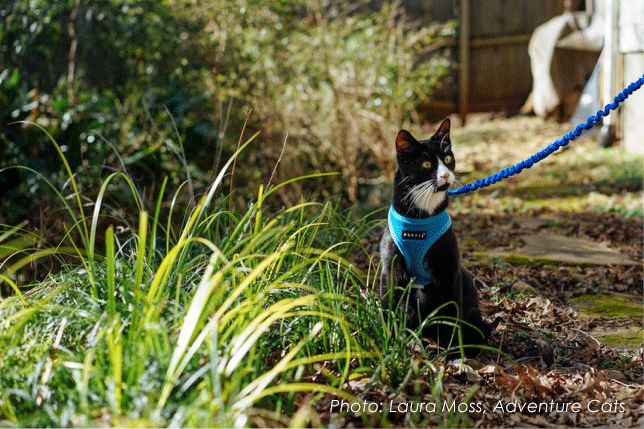The Outdoors Await! How to Harness Train Your Cat
By Laura Moss, Adventure Cats
My cats, Fiver and Sirius, have always been captivated by the world outside the window. They spend hours lounging in sun puddles, watching birds and squirrels, and delighting in outdoor scents whenever I crack a window.
and squirrels, and delighting in outdoor scents whenever I crack a window.
In fact, one of my cats, Fiver, was so fascinated by the outside world, that he began creeping close to the door whenever it opened. Once, he even dashed outside to see just what was out there. Since we’d rescued him as an injured kitten, Fiver hadn’t ventured outdoors, so he certainly wasn’t prepared for the sights, scents and sounds that bombarded him when he slipped outside, and he was quick to return to the familiarity of the house.
Clearly though, my cats were craving what the outdoors had to offer, which makes sense. Studies show that the house panthers we share our lives with actually aren’t that far removed from their wild ancestors, and our feline friends need physical activity and mental stimulation to remain happy and healthy.
While plenty of cats live fully enriched lives indoors, other cats need access to the great outdoors. Occasional exploration can keep cats active and stimulated, which can prevent and even alleviate many boredom-related problems, such as depression, aggression and eliminating outside the litter box. For some cats, a little outdoor walk can even help alleviate pain.

Luckily, there are countless ways to safely provide your kitty with a taste of the great outdoors, from simply opening a window or building a catio to going for a stroller ride or taking a leashed walk. But how exactly do you go about leash training a cat?
It’s all about ‘pawsitive’ reinforcement
First, you need to find a comfortable cat harness that fits correctly. Never attach a leash directly to a cat’s collar as this can be extremely dangerous.
Next, it’s time to introduce the harness. Some cats may easily take to a harness on day one and be ready to go, but most will need some time to acclimate to the new sensation. While kittens are certainly the easiest to leash train because they’re so open to new experiences, most cats of any age can be trained to wear a harness with a little patience and positive reinforcement. And for kitties, positive reinforcement often means something delicious, such as treats or wet food.
To start out slowly, simply place the harness beside your cat’s food dish or feed him treats on it. The key here is to help your kitty associate the harness with a positive experience.
Once your cat is aware of the harness, slip it on him while you’re indoors, but don’t snap or buckle the harness and adjust it just yet. Do this during mealtime or while providing a food reward. Let your kitty get used to this new sensation, and don’t be alarmed if your cat falls over, walks funny or refuses to walk at first. This is completely normal since your cat isn’t used to wearing a harness.
Give your cat some time to get comfortable in the harness, and be patient as it may take days or even weeks for a cat to fully adjust to the sensation. If your cat seems frightened or upset, remove the harness and provide treats or a distraction in the form of a favorite toy or some catnip or silver vine. Once again, the trick is to make each experience with the harness a positive one.
‘Purrparing’ to go outside
When your kitty is walking comfortably indoors in a well-fitted harness — it should fit snugly and you should be able to fit no more than a finger or two between the harness and your cat — attach the leash. Practice gently leading your cat with the leash, but understand that a cat may never walk on a leash like a dog. Often, leash-trained cats are “purrfectly” happy lounging around in the grass or meandering about the yard and may never be interested in traversing great distances.
Now that your feline friend is used to walking on a leash, it’s time to go outside. But first, ensure your cat is microchipped, wearing a collar and up to date on all vaccinations, as well as flea-and-tick treatments.
Begin somewhere quiet and close to home, such as a backyard, and always carry your cat out the door. You don’t want your cat to get used to walking out the door in his harness or he just might think it’s okay to one day walk out without a harness.
While you’re outdoors, keep a close eye on your kitty and let him explore at his own pace. Keep the leash loose in your hand, and don’t try to force him to venture anywhere until he’s ready.
It’s a good idea to stay near an open door or to provide a familiar safe space such as a carrier, so your kitty can retreat if he becomes frightened. You may also want to bring a towel outside the first time in case your cat gets scared and you need to wrap him up quickly and carry him back inside.
With regular outings, your cat will become more comfortable outside and likely enjoy the opportunity to explore the world outside the window just like Fiver does.
To learn more about leash training cats and safe ways your kitty can join you in the great outdoors, visit AdventureCats.org.








_200_49.png)



_200_175_75.JPEG)











